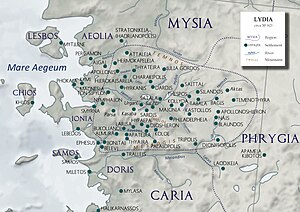Hypaepa
Hypaepa | |
|---|---|
| Coordinates: 38°13′52″N 27°58′19″E / 38.23111°N 27.97194°E | |
| Country | Turkey |
| Province | İzmir |

Hypaepa or Hypaipa (
Name and location
Its name was derived from its situation at the foot of Mount Aipos,[further explanation needed] itself a southern foothill of Mount Tmolus,[4]
Its location was identified by the Frenchmen Cousinéry and Texier and confirmed by the excavations carried out by Demostene Baltazzi on behalf of the
Its position looking towards the plain of
History
In fact, the Roman poet Ovid contrasted the great city of Sardis with what he called "little Hypaepa": Sardibus hinc, illinc parvis finitur Hypaepis.[5]
Coinage of Hypaepa of the 3rd century AD are extant,
To judge by the number of Byzantine churches that it contained, Hypaepa flourished under the Byzantine Empire.[4]
Mythology and pre-christian religion
The women of Hypaepa were reputed to have received from the mythological Aphrodite the gift of beauty of form and dancing[6] Ovid placed at Hypaepa the home of Arachne before she was turned into a spider.[7]
The
Pausanias mentions a rite performed in Hypaepa, in which wood was set alight apparently by magic.[8]
There was a temple of Priapus at the city.[9]
An inscription from the synagogue of Sardis mentions a benefactor who was a member of the council of Hypaepa, indicating the presence there of a Jewish community.[4]
Ecclesiastical history
Bishopric
Hypaepa was an
Under
Titular see
The Latin diocese was nominally restored as
It is vacant since decades, having had the following incumbents, all of the lowest (episcopal) rank :
- Edward Gilpin Bagshawe, Seleucia Trachea(1904.01.17 – 1915.02.06)
- Augustin Henninghaus (韓寧鎬), Divine Word Missionaries(S.V.D.) (1904.08.07 – 1939.07.20)
- Raymond Aloysius Lane (林化東), Maryknoll Fathers(M.M.) (1940.02.13 – 1946.04.11)
References
- ^ Dictionary of Greek and Roman Geography (1854) William Smith
- ^ a b William Smith, Dictionary of Greek and Roman Geography (1854)
- ^ Harry Thurston Peck, Harpers Dictionary of Classical Antiquities (1898)
- ^ a b c d e f g h Encyclopedia of the Hellenic World, "Ύπαιπα (Αρχαιότητα)
- ^ Ovid, Metamophoses, 11.146, l. 152; English verse translation
- ^ a b c d Sophrone Pétridès, "Hypaepa" in Catholic Encyclopedia (New York 1910)
- ^ Ovid, Metamorphoses, VI
- ^ Pausanias V 27:5-6 text at Perseus
- ^ Petronius, Satyricon, §133
Sencan Altınoluk, Hypaipa. A Lydian City During the Roman Imperial Period, Istanbul, 2013.

